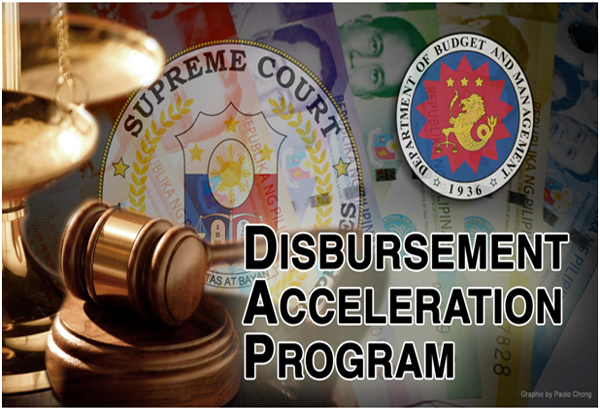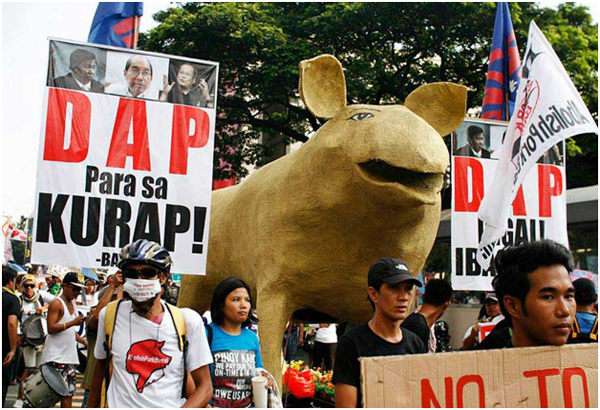DAP and the Politics of Budgeting

At a time of intense public debate about the continuing fall-out from Mamasapano and the fate of the BBL, it is easy to lose sight of a significant and far-reaching Supreme Court decision clarifying the status of the DAP that was handed down earlier this month. In July of 2014, the Court flatly declared the DAP unconstitutional. The recent decision from February of this year modifies that stance considerably.
At stake is the power of the Executive to withdraw unobligated and unused funds from agencies and define them as “savings” prior to the end of the year. Such funds could then be re-directed for the completion of other government projects already underway. The DAP was meant to rationalize and speed-up government expenditure. Ideally, it was supposed to be a tool of progressive budgeting, meant to be an efficient way of directing public spending to spur much-needed development.
However, the effectiveness of the DAP has been the subject of much debate. The Executive has defended the DAP, saying that it is an important stimulus tool that has helped spur the economy’s remarkable growth during the first few years of PNoy’s administration. However, a COA audit of government spending in 2013 indicated that the DAP has been less than effective. It found that four government-owned and -controlled corporations (GOCCs) had more than P2.4 billion in unused DAP funds that had to be returned to the national coffers after the Supreme Court struck down parts of the DAP as unconstitutional.
Such debates underline a simple fact. Budgets are not only tools for development. They are inevitably objects of political contestation liable to abuse. Congress is constitutionally mandated to churn out the giant sausage that is the national budget. It is far from a smooth process inasmuch as it always runs the risk of short-changing the public good. Funds targeted for a schoolhouse or a convention center in the city of “x” could end up being re-directed to the pockets of “y” and his/her family and friends. From a tool of development, budgets are vulnerable to becoming fuel for corruption.
One spectacular example was the recent case of legislators working in collusion with fake NGOs to use their PDAF, that is, their share of the budget, to stash millions and more into their own bank accounts. The revelations of such corrupt practices stirred mass anger, and flew in the face of the administration’s pledge to quell corruption. In the generalized anger that swept across the country, the DAP was conflated with PDAF. The Supreme Court last year agreed and declared both to be unconstitutional. One regrettable effect was to freeze government spending on a number of projects even if none of them showed any evidence of having been used for corrupt purposes.
It is within the context of the double nature of the budget as either a tool for development to benefit the public good or a vehicle for corruption for private gain, that the modification of the SC ruling on DAP remains significant. DAP represented money gained from “savings” from projects that had yet to be used for other projects. It meant, for example, shifting the funds from Bridge A that were never begun in City B to finish a highway or build a health clinic in Province C. But everything hinged on how “savings” would be defined. Was it something that could only realized, as it has usually been, at the end of the fiscal year from the unused funds of projects that appeared in the budget? Or was it something that could be culled anytime? Who determined when something became “savings”: Congress or the President? Did its use as part of the DAP amount to a violation of the Constitution,whereby the Executive usurped the role of the Congress’s mandate to determine the budget itself?
When the Court declared certain portions of the DAP unconstitutional, the President’s Congressional allies responded by redefining “savings.” They drafted legislation that gave the Executive greater leeway to determine what constituted savings, and when and where to re-allocate them. This would give the Executive greater flexibility in future augmentations. Of course, with this financial capacity comes greater political power as the President now has greater access to funds that he can use with greater latitude, relatively free from Congressional oversight. Some critics have signaled the dangers inherent in this development. By granting greater power to the President to decide on savings, Congress has essentially ceded a large chunk of its budgetary power to the Executive. It is not difficult to imagine, such critics claim, how future presidents could easily abuse this privilege and use DAP funds to extend and consolidate patronage ties to local politicians.
There are other significant changes in February’s Supreme Court ruling. For one, the Court held that DAP-funded programs that began before the Court’s July decision can continue (as per the “doctrine of operative fact”). The other has to do with the “presumption of good faith” extended to those who have been implementing DAP-funded projects. Unless otherwise riddled with corruption, such projects could continue. This decision is enormously helpful. The earlier SC decision had had a chilling effect throughout the Executive branch. Many agencies were afraid to spend their budgets. The “presumption of good faith” means that they could now move ahead with their projects without fear of undue prosecution.
The SC decision also helped clarify an important distinction between PDAF and DAP. The latter entailed shifting funds from one government program to another. With PDAF, money all-too-often got shifted from programs to pockets. While it is understandable that people would think that DAP, like PDAF, would become a source of corruption to the extent that it enlarges presidential power over the budget, the fact remains that no such evidence of wrong-doing has emerged. Furthermore, as former National Treasurer Liling Briones points out, “If we want indicators of possible bad faith, we should examine individually the programs supported by DAP. This can be done because there are already reports on DAP-funded projects. The more difficult question to answer is: Whose projects were stopped, cancelled, and written off? Bear in mind, no new funds were created for DAP. Existing funds for appropriated projects were pooled to fund DAP.”
While suspicions of corruption understandably linger, we should also note the fact that the DAP has brought with it undeniable benefits under this administration. According to DBM figures, when DAP got under way in the last quarter of 2013, disbursements increased by 32.5 percent, which pulled public spending out of the negative zone to show an increase of 2.3 percent for the full year.
We then saw an increase of 14.1 percent in 2012 and 5.8 percent in 2013. Better conditions and sustained growth have resulted from these increased disbursements. (Disbursements in this year’s GAA are slated to increase by 15.1 percent.) Infrastructure spending alone improved from a negative 28.7 percent in 2011 (indicating projects going un-funded), to positive 27.6 percent growth in 2012 and 21.6 percent in 2013.
The overall economy felt the benefits as well. Improvement in the pace of public spending, according to the World Bank, bolstered the growth of the country’s GDP. Their 2012 report stated that the DAP “was partially successful and contributed 1.3 percentage points to GDP in Q4 [of 2011].” The country’s GDP growth further improved from 3.6 percent in 2011, to 6.8 percent in 2012 and 7.2 percent in 2013.
All told, the public outrage over corruption has had a salutary effect on the politics of budgeting. It resulted in the investigation and prosecution of some of the more egregiously corrupt senators who now sit in jail awaiting their trials. In declaring parts of the DAP unconstitutional, the Supreme Court has also consigned the PDAF to the trash bin of unconstitutional budgeting gimmicks. Additionally, the Court’s ruling has underlined the extent to which power over the purse is a site of constant struggle between the different branches of government. It has forced the Executive to clarify and streamline its own budgeting process, and Congress to redefine the meaning of “savings” in this year’s GAA that gives the President greater flexibility, but also greater power.Finally, the Court ruling has cleared the way for agencies who have received DAP funds to continue providing public services free of worry about breeching the Supreme Court decision.
Still, budgeting continues be risky business. Its developmental potential is never free from political infighting and deal-making. Whether it is Congress or the Executive who decides on the meaning of savings and on the re-allocation of funds, the budget -- the connective tissue of government, if you will -- will always be prone to the hazards of corruption. Thus, the urgent need to be vigilant, demanding transparency, honesty and professionalism not only from all branches of government but also from the officials who claim to represent them.

Million People March 2 at Ayala Avenue, Makati, Oct. 4, 2013. PHOTO BY MON RAMIREZ (bicoltoday.com)
- Latest
- Trending



























